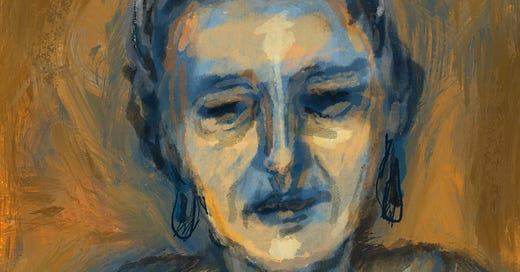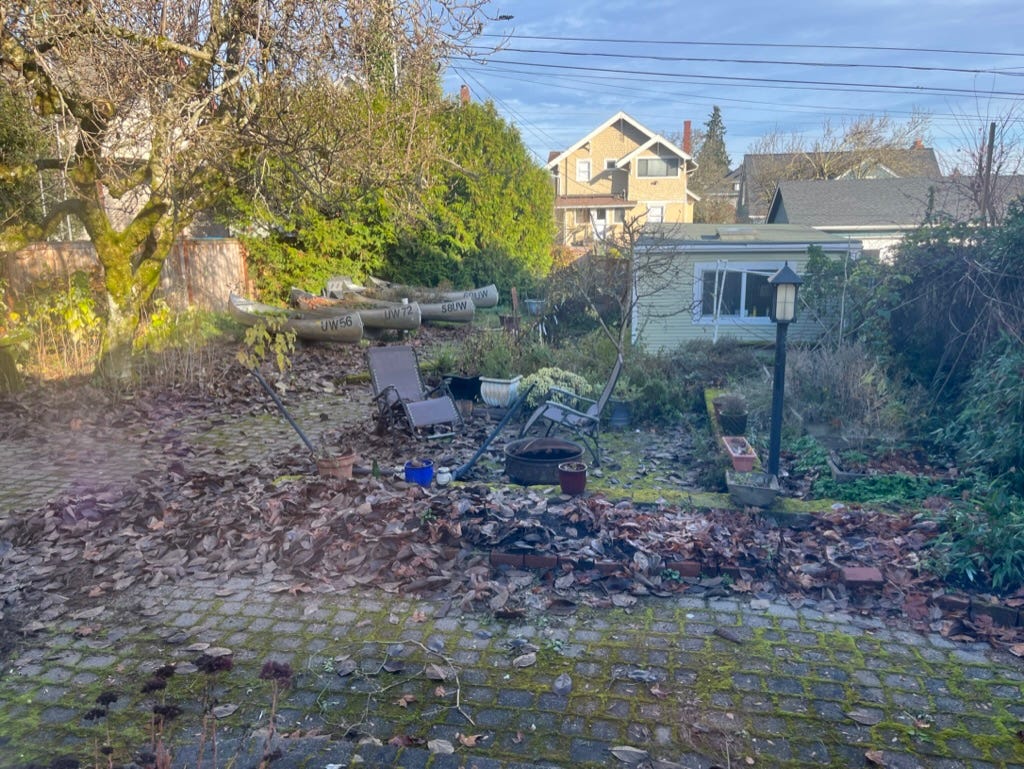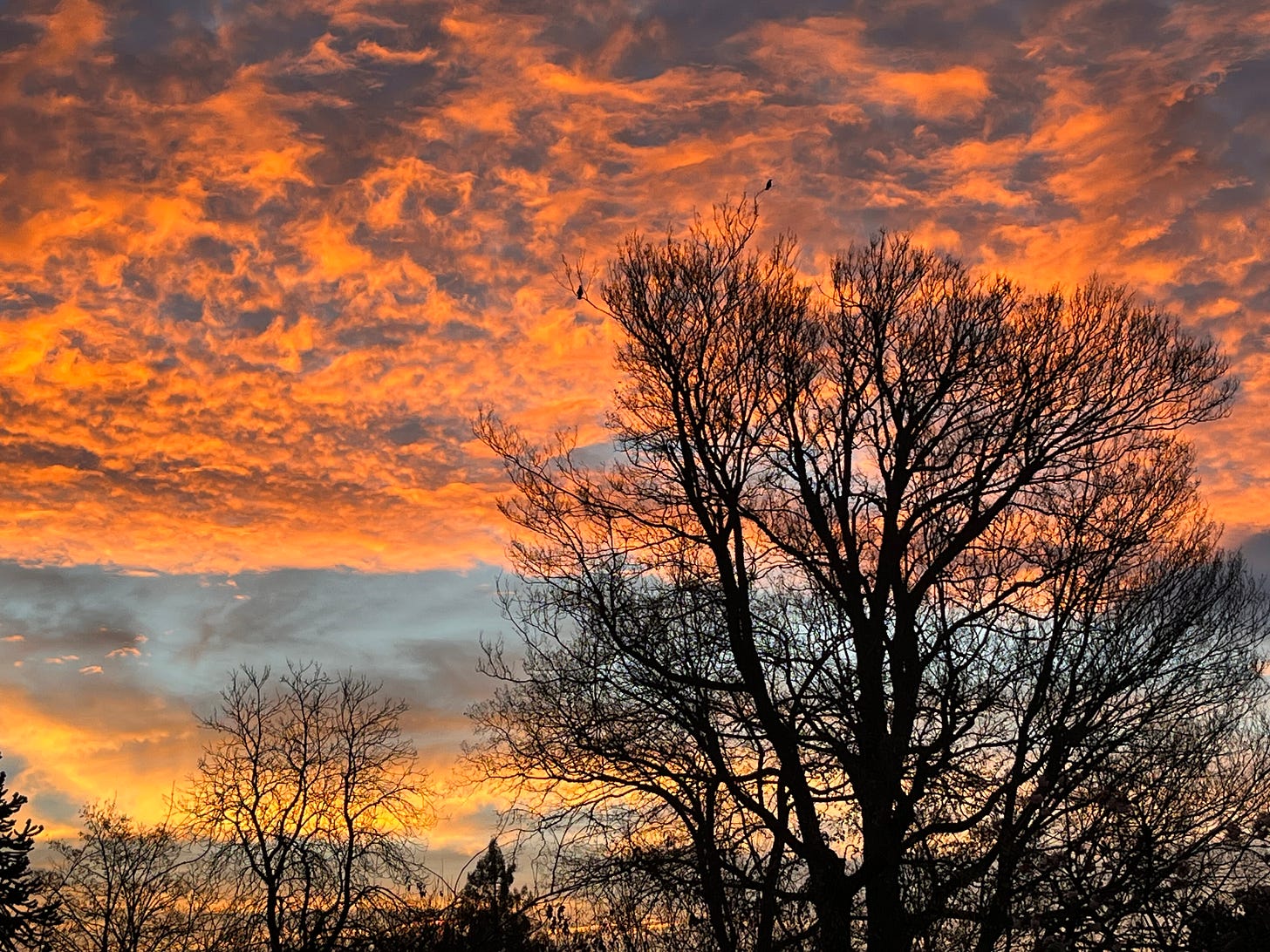In the landscape of global news of continuing genocides, rogue fascism, and unexpected regime changes, this essay seems a bit of an indulgence. For that reason and others, it’s taken weeks to untangle what I need to process about the topic of aging, but given that I’m about to leave town for a few days, I’m using this as an incentive to finish this post. My inner critic is having a field day with what I’ve written thus far, but I’m just going to have to leave it where it is.
I’ve been rising to the challenge of developing new habits and rituals that will ground me in this time in the world. My latest morning ritual has been to write a few sentences to my ancestors in a very special journal gifted to me by my wonderful housemate, Stevi Rose. This journal is actually a Jewish calendar, created by two queer, anti-Zionist Jews who are friends of Stevi’s. Since I typically don’t use book calendars (my digital one is sufficient for my needs), I decided to repurpose this one to serve a particular focus. My ancestor altar was refreshed last week, with new postcards, candles, and a variety of special stones and memorabilia that feel sacred to me; this new journal clearly belonged in this regenerated corner of my home office.
I am curious, as a non-practicing Jew, what this calendar can teach me since it has stories and suggestions tucked into various sections, highlighting practices that are mostly unfamiliar to me. After lighting some candles, a bit of incense, and speaking to the ancestors aloud, I write a few sentences to fit within the space allotted for each date. Sometimes I address my ancestors by name, sometimes I just write to the whole flock, and other times, it just flows into the ethers.
After I conclude my writing, I just sit & meditate looking out at the garden in its winter phase. Amongst the downed leaves of the magnolia tree, I often see a few birds and squirrels sniffing for nourishment and munching away. As I breathe slowly, taking in the scene, my brain takes a leap into some future where there are fewer critters ambling about, with much less to eat. Troubling scenes of things getting less comfortable and bountiful on our fragile planet have plagued me since childhood. Of course, there are many places on the planet where the discomfort of ecocide and colonial exploitation has been experienced for centuries. But in my backyard, when I forget my status as a settler, those troubles seem far away.
My tendency to pull those disturbing images into my imagination has been reinforced by a pop culture obsessed with humanity’s self-destructive nature and a steady stream of dystopic films. Conjuring up tragic images where there is nothing visibly awry has been a habit reinforced by my activism. My work as an activist artist was often focused on finding ways to shake people out of their numbness and denial, but as more folks seemed to be waking up, I have found myself trying to offer art medicine that would help them process their despair and connect with others to shift things.
In this present moment, as I move through compounded grief, I have habituated myself to lift up that which offers joy. My practices remind me that catastrophic thinking does not help. It increases one’s suffering, does not alleviate the suffering of others, and does not help me appreciate the view outside my window. Even with the frost appearing on the edges of the mulching leaves, I can see the fecundity that remains present, evidenced by the expansive, rich green moss bulging out of the pavers since the rainy season started.
Writing is like a spell to keep me present to what is, even if my heart is breaking. And looking at the world with wonder, like this morning’s sunrise, also offers medicine.
Despite these rituals, over the past few weeks, I have been filled with a piercing sadness for all the losses. I am allowing this sorrow to just be, waiting for it to be ready to release, knowing that this process will likely continue until I become “good soil.” As part of this process of releasing, I decided to de-clutter.
My desk, where I am currently sitting, has been in a continual whirlwind for years. In my efforts to control what I can, in this very chaotic time, not only was the desk going to get a makeover, but I was going to do an inventory of my vast collection of postcards and photos to change the visual landscape surrounding my desk.
As I began looking at analog photos, I decided it was time to convert digital photos into tangible ones for a photo album for my son. This process was deeply engaging, but it challenged my emotional stability; joy and heartbreak danced through my memory banks. Without much caution, I felt like I was leaving past chapters behind, and it was (and is) necessary to do this. Somehow I seemed to understand the need to plow into grief like a farmer readying the soil for planting.
A side effect of this digging into the past was an unexpected harvest of ruminations on the topic of getting OLD. Becoming a widow and an empty nester, soon after leaving academia, while in pandemic times, seemed to have tossed me into elder-hood with an unforgiving thud. Being called one of the “wise elders” in the spaces I’ve attended in the past 6 months, has made me want to pause, take a deep breath, and consider the roots of my denial. Of course, being placed in a container of wise elders is not an insult, but my brain clearly needs to catch up with the timeline I’ve been traveling. Unsurprisingly, I have a list of excuses. So bear with me as I indulge in this exercise of finding my right age in this moment.
I was the baby in my family, the baby in my generation of cousins, and the youngest in my class in school. I married someone 5 years older than me. Our son asked to come in (that’s another story for another day) when I was 40, and I learned that my status in the OB/Gyn world was as a geriatric mom (that was my first heads up about aging). During our years in a small village in Western Massachusetts, when our son was small, I hung out with moms who were many years younger than myself, and I may have deluded myself to think that I was their age.
In some ways, getting disabled by an environmental illness in my late 30s was a big lesson in aging. It was humbling to discover that my body had serious limitations due to the unavoidable, aerial ingestion of pesticides. I was so in the thick of it, trying to find the right protocols so that I could get well, that the topic of aging was far from my mind. What little capacity I had at the time was centered on getting through my pregnancy, and completing a project called, “OUT OF BREATH,” for an exhibition in the gallery at CSU Long Beach. A few years after my son’s birth and our move to a rural community, I began my digital project, CANARY NOTES: The Personal Politics of Environmental Illness that looked at the systemic causes of multiple chemical sensitivity and the increasing number of environmental refugees with chronic illnesses.
Ultimately, when I did get well, after many years of effort, it was a spiritual and creative shift that catalyzed physiological changes - and this, along with a regimen of supplements and anti-inflammatory eating, allowed for healing to happen. This healing process, as difficult as it was, was truly remarkable (because few people with this kind of chronic illness do recover). And it made me a bit smug about aging (so much for my spiritual awakening). Then getting hired for a tenure-track position at age 50, after being a persistent applicant and a finalist 18 times, added more fuel to that smugness fire, reinforcing my denial about aging.
I inherited a good set of genes that offered me the distinction of looking younger than I am, and it’s only in the past two years since Bob’s illness and death, that gray hair and the impact of stress and gravity have appeared. When I’m told that I don’t look my age, something that my mom would always brag about herself, I shudder a bit. That kind of vanity offers a superficial balm that wears thin with time, and the ageism implied with that form of “praise” often evades well-meaning folks.
It’s funny how we don’t see ourselves as “old” until it’s mirrored back to us in ways that we can no longer avoid. I have thought of myself as a very alive, active, and curious person, not so different other earlier iterations of my life, but my appearance and experience now reveals things that I don’t see so readily in the mirror or in a Zoom rectangle. While I was startled when I was addressed as the “wise elder” in a recent in-person gathering, I also recognized that the material covered in our seminars included the teachings of leaders, visionaries, and thinkers who had been part of my education and training decades earlier. As I became aware of the vastness of my experience relative to the younger folks in the room, I realized that I was experiencing an “elder initiation.” Although uncomfortable at first, I’m becoming more at ease with this new role, especially in the context of intergenerational collaborations.
In several online presentations that I’ve attended in the past few years, as well as podcasts that have gifted me with refreshing ways to reframe things, I’ve heard the complaint that there just aren’t enough wise elders to help us through this time. I recognize that there needs to be a collective effort on the part of my peers to offer mentoring and guidance, but arrogance and hubris needs to be composted before we can come into right relation with others. We elders have so much to learn from our younger siblings, and we must remain curious and open if we are going to thrive in our elderhood. If we’re going to offer next generations more opportunities in how to think critically and embrace diverse histories, how to calm the nervous system, how to have a permeable ego so we can collaborate, how to take creative risks, how to think strategically and systemically, and so much more, it will require enormous imagination and innovation to exist in the cracks of the collapse.
When I get discouraged, I call my friend, Thalia, who I’ve known for 46 years. She is a happy 91-year old, as well as a recent widow. She is one of my mentors in the fine art of aging. She is fortunate because she has good health, has her own teeth, can walk without assistance, and has sufficient savings to live in a good assisted living facility. Every day is an adventure for her: she continues to learn about herself, listen with delight to the stories of others, relishes her comforts, reads books, spends time in nature, volunteers to visit residents with dementia, and takes walks with a friend.
Another mentor is Dot Fisher-Smith, an artist who I met when attending a retreat for activist artists led by Thich Nhat Hanh at the Ojai Foundation in 1989. My late husband and I visited her and her husband in Ashland, Oregon, while on our honeymoon roadtrip and she announced that she would soon have her hair shorn as part of a croning ceremony. Although I have not seen Dot since then, I never forgot her joy about entering crone-hood, and how thrilled I was to discover in a reel on IG that her history and wisdom had been documented by several filmmakers.
I will leave this post here, and say as a final note, I never imagined that I would live this long, and assumed like many of my peers that I would not make it to age 30. Now that I have doubled that number, plus a decade, I can say that I am just grateful to be here to heal, connect, dance, love, and be present for whatever is unfolding.
Thanks for your patience, dear reader.








Wow just what I needed today in mirad ways. Future Good Soil you are and I shall be, thank you Thalia, Courtney (my Mentor) and Bee (the other one). xxx
Thank you Beverly for such a grounding, encouraging and yet very real post. I am around 10 years your junior but already thinking much about this. Many cycles are ending for me in the next few months. Much much appreciation for your work and way of living...